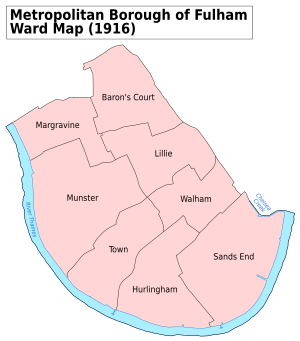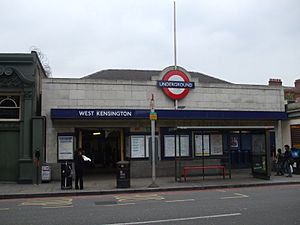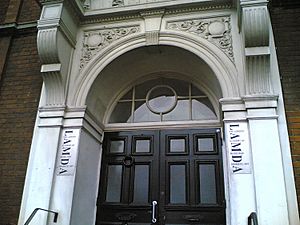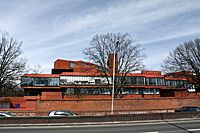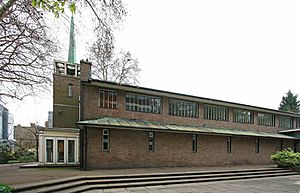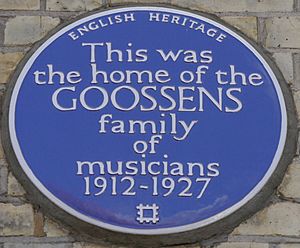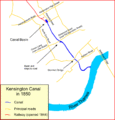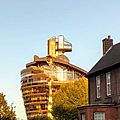West Kensington facts for kids
Quick facts for kids West Kensington |
|
|---|---|
| OS grid reference | TQ246783 |
| London borough | |
| Ceremonial county | Greater London |
| Region | |
| Country | England |
| Sovereign state | United Kingdom |
| Post town | LONDON |
| Postcode district | W14 |
| Dialling code | 020 |
| Police | Metropolitan |
| Fire | London |
| Ambulance | London |
| EU Parliament | London |
| UK Parliament |
|
| London Assembly | |
West Kensington is a lively area in London, England. It's part of the London Borough of Hammersmith and Fulham. This area is about 3.4 miles (5.5 km) west of Charing Cross, a famous spot in central London.
West Kensington covers most of the W14 postal area. It includes places near Barons Court tube station. The area is bordered by Hammersmith to the north and Earl's Court to the east. A big road called the A4, also known as Talgarth Road, runs right through it. The main local street is North End Road.
This area is mostly residential, meaning many people live here. You'll find the famous Queen's Club here. It's also close to the Olympia Exhibition Centre and busy areas like Fulham and Hammersmith Broadway.
Contents
History of West Kensington
In 1876, two builders from Dorset, William Henry Gibbs and John P. Flew, had an idea. They wanted to build a new area like 'South Kensington' on the market gardens west of the West London Railway. They built 1,200 houses in a village called North End.
However, in the 1880s, there was a housing slowdown. Many of their houses didn't sell. So, they decided to rename North End to 'West Kensington'. They also planned to build a bridge over the railway to connect their new estate to the fancy Cromwell Road in Kensington.
They succeeded in renaming the area. But the bridge plan led to them going bankrupt in 1885. Later, local people pushed for the bridge, and the West Cromwell Road bridge was finally built between 1938 and 1942.
Homes in West Kensington
West Kensington is mainly a residential area. It has many beautiful Victorian terraced houses. Many of these houses have been divided into flats. You can see great examples of Victorian architecture here.
Some houses and even whole streets are listed. This means they are protected because of their special history or design. Examples include the large apartment buildings on Fitzgeorge Avenue and around Avonmore Road. These include Glyn Mansions (built 1897) and Avonmore Gardens (built 1893).
West Kensington Court was built in 1938. It offered what were considered luxury flats for young people and families. There are also some buildings that used to be owned by the local council. A newer private development, St Paul's Court, was built in 1980.
People and Cultures
West Kensington is a very diverse place. Many different cultures live here. You'll find people from Arab countries, America, Australia, New Zealand, Ireland, Italy, Spain, and France. Some private schools in the area even teach in these native languages.
The area also has many students. This is because it's close to big universities and hospitals. These include Imperial College London, Charing Cross Hospital, and other universities in Central London.
Location and Local Life
West Kensington has a great location. Because it's near wealthy areas like Kensington, it has more special shops and restaurants. The area sits on the border between the Hammersmith & Fulham and Kensington & Chelsea boroughs.
Even though it hasn't had as much new development as nearby Earl's Court and Fulham, new buildings and renovations are still happening. For a while, W14 was the only London postcode area without a post office. But a new sub-post office opened in North End News in 2009.
 |
Shepherds Bush & Hammersmith | Shepherds Bush & Notting Hill | Notting Hill & Holland Park |  |
| Hammersmith | Kensington | |||
| Fulham & Hammersmith | Fulham & Earl's Court | Earl's Court & South Kensington |
Getting Around West Kensington
West Kensington has excellent public transport options.
Underground Stations
There are three London Underground stations right in the W14 area:
- West Kensington (on the District line)
- Barons Court (on the District and Piccadilly lines)
- Kensington (Olympia) (on the District line and London Overground)
Several other stations are very close by, making it easy to travel across London:
- Hammersmith (District and Piccadilly lines)
- Hammersmith (Circle and Hammersmith & City line lines)
- Earl's Court (District and Piccadilly lines)
- High Street Kensington (District line)
- Fulham Broadway (District line)
- West Brompton (District and London Overground)
- Gloucester Road (District, Circle and Piccadilly lines)
- Goldhawk Road (Hammersmith & City and Circle lines)
- Shepherd's Bush (Central and Hammersmith & City lines)
Overground and Buses
- Overground: You can catch the London Overground from West Brompton station, Kensington (Olympia) station, and Shepherd's Bush.
- Bus: Many bus routes serve the area, including the 9, 23, 27, 28, 49, 306, and C1. These buses connect West Kensington to places like Acton, Chiswick, Hammersmith, King's Cross, Notting Hill, and Trafalgar Square. There's even a night bus (N9) that goes to Heathrow Airport.
Roads
West Kensington is also close to the A4 road (West Cromwell Road). This road connects to western parts of London and Heathrow Airport. High Street Kensington also provides links to Central London.
A fun fact about transport here is the London Underground training centre. It has a fake station called West Ashfield tube station. This is where staff learn how to operate the trains.
Cool Places to Visit Nearby
- Queen's Club – a famous tennis club that hosts the Queen's Club Championships
- Olympia Exhibition Centre – a large venue for events and exhibitions
- Sotheby's – a famous auction house with a sales room at Olympia
- Blythe House – stores for the Victoria & Albert, Science, and British Museums
- North End Road Market – a lively street market
- Charing Cross Hospital – a major hospital
- Earls Court Exhibition Centre – a former exhibition centre site
- Kensington High Street – a popular shopping street
- Holland Park – a beautiful park
- Hyde Park – one of London's largest parks
- Fulham Broadway – a shopping and entertainment complex
- Hammersmith Broadway – another busy shopping area
- Hammersmith Apollo – a famous music and comedy venue
- Westfield London – a huge shopping mall
West Kensington in Pop Culture
West Kensington has appeared in films and books!
- Blythe House was used as a filming location for movies like Tinker Tailor Soldier Spy.
- In the film Trainspotting, a flat on North End Road, opposite West Kensington tube station, is featured.
- The Nashville Rooms, now a pub called Famous Three Kings, was a famous spot for rock and punk concerts in the 1970s. Bands like Joy Division, The Sex Pistols, and The Police played there.
- In Hanif Kureishi's novel The Buddha of Suburbia, the main character lives near the Nashville Rooms in West Kensington.
- The 1969 BBC series 'Take Three Girls' featured a flat at 17 Glazbury Road.
Future Plans for the Area
There are big plans for the future of West Kensington. The local councils have approved a large project called the Earl's Court Project. This project will redevelop the land around the former Earl's Court Exhibition Centres and the West Kensington & Gibb's Green Estate.
This project is expected to take 15-20 years. It includes creating four new village centres around North End Road, West Kensington, West Brompton, and Earl's Court. This will bring many benefits to the area.
Shops, Schools, and Churches
West Kensington has many small shops, offices, and restaurants. The Olympia Exhibition Centre is also nearby. It's easy to get to the shopping areas of Earl's Court, Fulham, and Hammersmith.
There are several pubs and hotels. The Albion pub is even said to be haunted! The Baron's Court Theatre is located in the basement of The Curtains Up bar. One of London's oldest Polish bakeries, Prima, opened on North End Road in 1946.
Education in West Kensington
West Kensington used to have the large St Paul's School nearby. It was known for its beautiful Gothic-style buildings and playing fields. The school moved to a new location in Barnes in 1968. Part of the old St Paul's site is now home to the Ealing, Hammersmith and West London College.
West Kensington also has two St James Independent Schools for girls. The Fulham Boys School is a new independent school that has been temporarily located here.
The London Academy of Music and Dramatic Art (LAMDA) is a leading theatre school in the UK. It moved to its current location on Talgarth Road in 2005.
Churches in West Kensington
Even though it's called St Andrew's, Fulham Fields, this church is actually in West Kensington. It was built in 1873.
West Kensington's main church is St Mary's, located on Hammersmith Road. The original church was built in 1813 but was destroyed by a bomb in 1944 during World War II. The current church building was built in the 1960s.
Famous People from West Kensington
Many interesting people have lived in West Kensington:
- Edward Burne-Jones and Georgiana Burne-Jones: Edward was a famous Pre-Raphaelite painter, and Georgiana was a writer.
- Edward Elgar: A famous composer, he lived on Avonmore Road from 1890 to 1891.
- Estelle: The rapper and singer was born and grew up in West Kensington. Her song "1980" is about her childhood there.
- Mahatma Gandhi: The famous leader lived on Barons Court Road while studying law.
- Marcus Garvey: A very important Pan-Africanist leader, he lived and died in West Kensington.
- Eugène Goossens, fils and his family: This Belgian musician family, including famous conductors and harpists, lived on Edith Road West. A blue plaque marks their home.
- H. Rider Haggard: The author of King Solomon's Mines and She lived on Gunterstone Road.
- James Hunt: A Formula 1 racing champion, he lived in Normand Mews.
- Stirling Moss: A British Formula One racing driver, he was born in West Kensington in 1929.
- Sir John Tenniel: A famous artist and cartoonist, known for his work on Alice in Wonderland, lived on FitzGeorge Avenue.
- William Butler Yeats: The famous poet lived in Edith Villas with his family in 1867.
Images for kids
-
The Ark, Hammersmith
-
Entrance to Queen's Club during the 2005 Queen's Club Championships



